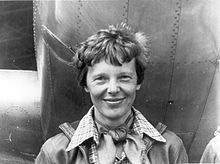
Back Amelia Earhart Afrikaans Amelia Earhart AN أميليا إيرهارت Arabic اميليا ايرهارت ARZ Amelia Earhart AST Amelia Earhart Aymara Ameliya Erhart Azerbaijani آملیا ارهارت AZB Amelia Earhart BCL Амелія Эрхарт Byelorussian
Amelia Earhart | |
|---|---|
 Earhart beneath the nose of her Lockheed Model 10-E Electra, March 1937 in Oakland, California, before departing on her final round-the-world attempt prior to her disappearance | |
| Born | Amelia Mary Earhart July 24, 1897 Atchison, Kansas, U.S. |
| Disappeared | July 2, 1937 (aged 39) Pacific Ocean, en route to Howland Island from Lae, New Guinea |
| Status | Declared dead in absentia[1] January 5, 1939 |
| Occupations |
|
| Known for | Many early aviation records, including first woman to fly solo across the Atlantic Ocean |
| Spouse | |
| Awards | |
| Website | www |
| Signature | |
Amelia Mary Earhart (/ˈɛərhɑːrt/ AIR-hart; born July 24, 1897; declared dead January 5, 1939) was an American aviation pioneer. On July 2, 1937, Earhart disappeared over the Pacific Ocean while attempting to become the first female pilot to circumnavigate the world. During her life, Earhart embraced celebrity culture and women's rights, and since her disappearance, she has become a cultural icon.[2] Earhart was the first female aviator to fly solo across the Atlantic Ocean and she set many other records;[3] she was one of the first aviators to promote commercial air travel, wrote best-selling books about her flying experiences, and was instrumental in the formation of The Ninety-Nines, an organization for female pilots.[4]
Earnart was born and raised in Atchison, Kansas, and developed a passion for adventure at a young age, steadily gaining flying experience from her twenties. In 1928, Earhart became a celebrity after becoming the first female passenger to cross the Atlantic by airplane. In 1932, Earhart became the first woman to make a nonstop, solo, transatlantic flight and was awarded the United States Distinguished Flying Cross.[5] In 1935, Earhart became a visiting faculty member of Purdue University as an advisor in aeronautical engineering and a career counselor to female students. She was a member of the National Woman's Party and an early supporter of the Equal Rights Amendment.[6][7] She was one of the most-inspirational American figures from the late 1920s and throughout the 1930s; her legacy is often compared to those of the early career of pioneer aviator Charles Lindbergh and First Lady Eleanor Roosevelt for their close friendship and lasting impact on women's causes.
In 1937, during an attempt to become the first woman to complete a circumnavigational flight of the globe in a Lockheed Model 10-E Electra airplane, Earhart and her navigator Fred Noonan disappeared near Howland Island in the central Pacific Ocean. The two were last seen in Lae, New Guinea, their last land stop before Howland Island. It is generally presumed they ran out of fuel, crashed into the ocean and died near Howland Island.[8] Nearly one year and six months after she and Noonan disappeared, Earhart was officially declared dead.
The mysterious nature of Earhart's disappearance has meant public interest in her life remains significant. Earhart's airplane has never been found and this has led to speculation and conspiracy theories about the outcome of the flight. Decades after her presumed death, Earhart was inducted into the National Aviation Hall of Fame in 1968 and the National Women's Hall of Fame in 1973. Several commemorative memorials in the United States have been named in her honor; these include a commemorative US airmail stamp, an airport, a museum, a bridge, a cargo ship, an earth-fill dam, a playhouse, a library, and multiple roads and schools. She also has a minor planet, a planetary corona, and newly-discovered lunar crater named after her. Numerous films, documentaries, and books have recounted Earhart's life, and she is ranked ninth on Flying's list of the 51 Heroes of Aviation.[9]
- ^ Van Pelt 2005, p. 205.
- ^ "Why does Amelia Earhart still fascinate us?". National Geographic. October 19, 2019.
- ^ Oakes 1985.
- ^ Lovell 1989, p. 152.
- ^ Goldstein & Dillon 1997, pp. 111, 112.
- ^ "Timeline: Equal Rights Amendment, Phase One: 1921–1972." Archived December 8, 2012, at the Wayback Machine feminism101.com. Retrieved: June 4, 2012.
- ^ Francis, Roberta W."The History Behind the Equal Rights Amendment." equalrightsamendment.org, July 21, 2011. Retrieved: June 4, 2012.
- ^ De Hart, Jane Sherron (1995). Ware, Susan (ed.). "The Perils of Flying Solo: Amelia Earhart and Feminist Individualism". Reviews in American History. 23 (1): 86–90. doi:10.1353/rah.1995.0004. ISSN 0048-7511. JSTOR 2703241. S2CID 201762326.
- ^ Cite error: The named reference
FlyingMagwas invoked but never defined (see the help page).
© MMXXIII Rich X Search. We shall prevail. All rights reserved. Rich X Search